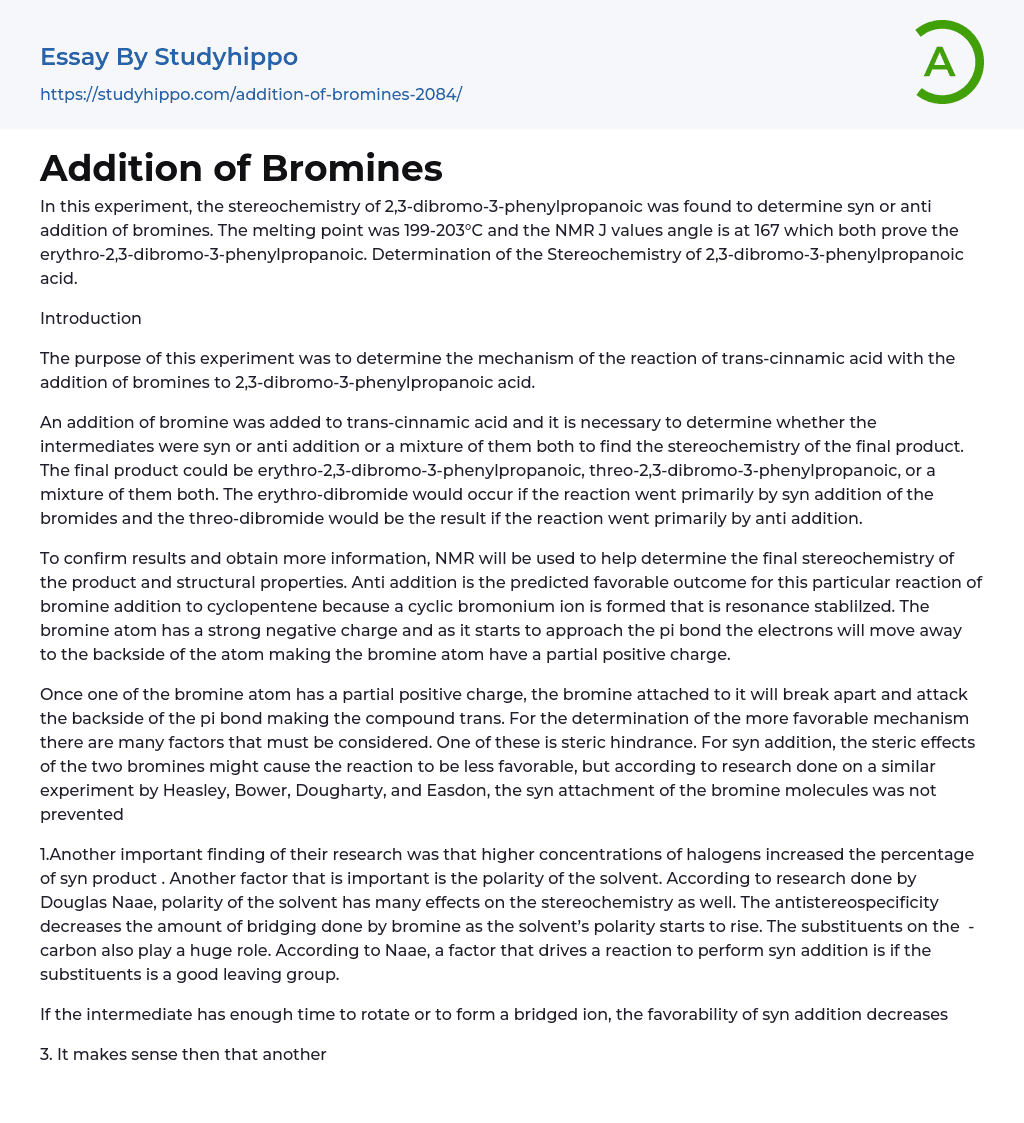

To Determine the Mechanism of the Reaction of Trans-Cinnamic Acid with the Addition of Bromines Essay Example
In this experiment, the stereochemistry of 2,3-dibromo-3-phenylpropanoic was found to determine syn or anti addition of bromines. The melting point was 199-203°C and the NMR J values angle is at 167 which both prove the erythro-2,3-dibromo-3-phenylpropanoic. Determination of the Stereochemistry of 2,3-dibromo-3-phenylpropanoic acid.
An addition of bromine was added to trans-cinnamic acid and it is necessary to determine whether the intermediates were syn or anti addition or a mixture of them both to find the stereochemistry of the final product. The final product could be erythro-2,3-dibromo-3-phenylpropanoic, threo-2,3-dibromo-3-phenylpropanoic, or a mixture of them both. The erythro-dibromide would occur if the reaction went primarily by syn addition of the bromides and the threo-dibromide would be the result if the reaction went primarily by anti addition.
To confirm results and ob
...tain more information, NMR will be used to help determine the final stereochemistry of the product and structural properties. Anti addition is the predicted favorable outcome for this particular reaction of bromine addition to cyclopentene because a cyclic bromonium ion is formed that is resonance stablilzed. The bromine atom has a strong negative charge and as it starts to approach the pi bond the electrons will move away to the backside of the atom making the bromine atom have a partial positive charge.
Once one of the bromine atom has a partial positive charge, the bromine attached to it will break apart and attack the backside of the pi bond making the compound trans. For the determination of the more favorable mechanism there are many factors that must be considered. One of these is steric hindrance. For syn addition, the steric effects of the two bromines might cause the reaction to
be less favorable, but according to research done on a similar experiment by Heasley, Bower, Dougharty, and Easdon, the syn attachment of the bromine molecules was not prevented
Another important finding of their research was that higher concentrations of halogens increased the percentage of syn product . Another factor that is important is the polarity of the solvent. According to research done by Douglas Naae, polarity of the solvent has many effects on the stereochemistry as well. The antistereospecificity decreases the amount of bridging done by bromine as the solvent’s polarity starts to rise. The substituents on the -carbon also play a huge role. According to Naae, a factor that drives a reaction to perform syn addition is if the substituents is a good leaving group. If the intermediate has enough time to rotate or to form a bridged ion, the favorability of syn addition decreases
It makes sense then that another factor that helps syn addition is if the concentration of the substituents is high and also when the halogen concentration is high. In an experiment by Antonius A. M. Roof, William J. Winter, and Paul D. Bartlett, they studied the kinetics of the reaction and found that syn isomer ends with serious compression issues on its bridge. They concluded that if any mechanism had a late transition state then syn the syn isomer would occur because there would be an easy access path to the carbon.
There are several ways that the reaction can go syn or anti, but syn addition will only occur if aided. Anti addition occurs when the carbon-carbon bond undergoes rotation and syn addition occurs when the intermediate collapses providing the means
for a carbocation to form. Methodology The general Procedure found in Lehman was used for this experiment. A variance in the procedure is that an NMR will also be used to analyze the results. The PCSpartanPlus molecular modeling system was used on Tuesday, January 17th, to calculate the frequency and the equilibrium geometry.
Conclusion
- For the syn addition of the bromines the mechanism would be the following
- For the anti addition of the bromines the mechanism would be the following
The final product was be erythro-2,3-dibromo-3-phenylpropanoic. It went through syn addition as shown by the mechanism because the molecule is more stable with the carbocation next to the benzene ring than it is with the bromine triangle. The data is backed up by the J values corresponding to the angles at 167 which was the erythro-2,3-dibromo-3-phenylpropanoic as well as with the melting point data which was only a few degrees off of the literature value for erythro-2,3-dibromo-3-phenylpropanoic and around a hundred degrees off of the alternate.
- Acid Rain essays
- Distillation essays
- Amylase essays
- Magnesium essays
- Acid essays
- Calcium essays
- Carbohydrate essays
- Carbon essays
- Chemical Bond essays
- Chemical Reaction essays
- Chemical reactions essays
- Chromatography essays
- Concentration essays
- Copper essays
- Diffusion essays
- Ethanol essays
- Hydrogen essays
- Organic Chemistry essays
- Osmosis essays
- Periodic Table essays
- Ph essays
- Salt essays
- Sodium essays
- Titration essays



